“Why do you want to go to Battambang?” we were asked by an inquisitive guest at our lodgings in Siem Reap. It was a good question and one that we could not convincingly answer. It seemed the obvious place to go after Siem Reap, mostly because, next to a dot on the map, the town’s name is written in bold letters.
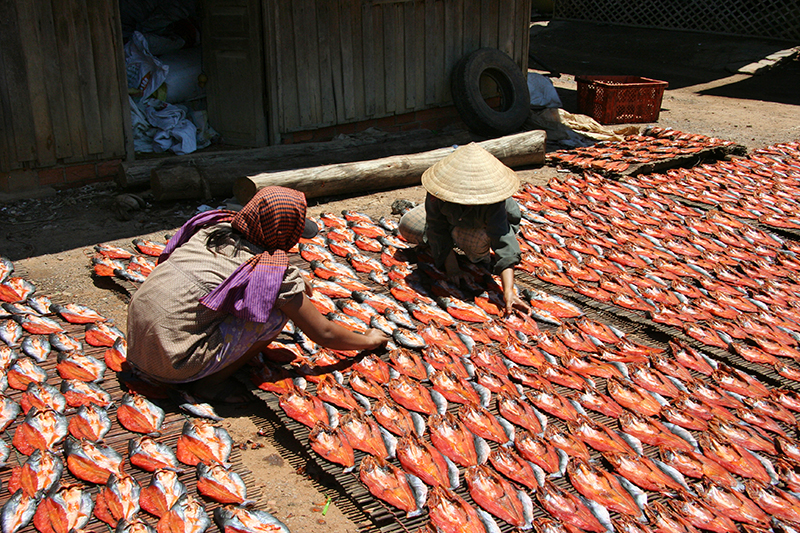 Battambang is around 60Km from the border with Thailand and has seesawed between Cambodian and Thai rule since time immemorial. Thanks to the support of the Thai Government, the area around Battambang was the last stronghold of the Khmer Rouge who were finally rooted out as late as 1998. The farmland around the town is flat and, at the moment, quite dry as everyone anticipates the arrival of the rains and the beginning of rice planting. The main activity at this time of year revolves around fish, oranges and coconut.
Battambang is around 60Km from the border with Thailand and has seesawed between Cambodian and Thai rule since time immemorial. Thanks to the support of the Thai Government, the area around Battambang was the last stronghold of the Khmer Rouge who were finally rooted out as late as 1998. The farmland around the town is flat and, at the moment, quite dry as everyone anticipates the arrival of the rains and the beginning of rice planting. The main activity at this time of year revolves around fish, oranges and coconut.
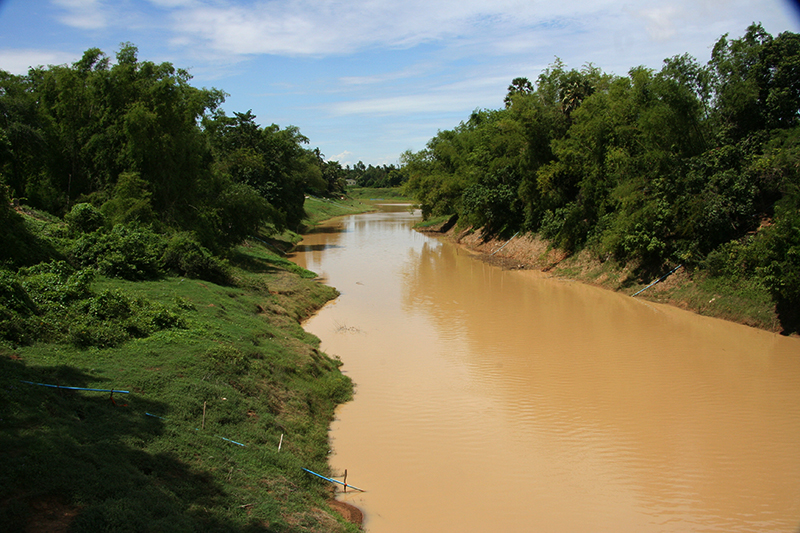 The town’s population of 140,000 is spread out but remains centred around the banks of the Stung (river) Sangker. The river waters are very low at the end of the dry season but, it is hoped, will rise by some 20 metres in the next two months to bring life once again to the arid land.
The town’s population of 140,000 is spread out but remains centred around the banks of the Stung (river) Sangker. The river waters are very low at the end of the dry season but, it is hoped, will rise by some 20 metres in the next two months to bring life once again to the arid land.
Battambang has grown up around a dark, dilapidated central market that has wet, smelly floors and all the usual aromas of green vegetables and dissected animals. The streets, laid out in a simple grid system are lined with brick and concrete buildings that are simply constructed and rarely maintained. As would be expected in a rural border town, the shops, restaurants and guesthouses are open to the road and cooled by large ceiling fans.
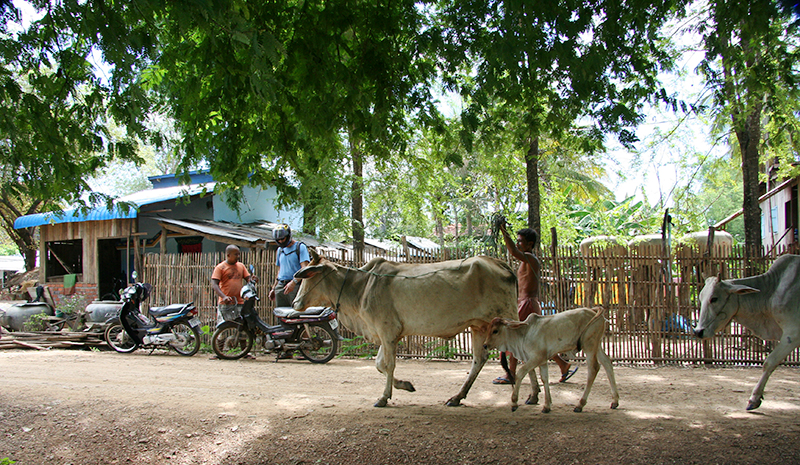 Dynamic and commercialised it certainly isn’t. But it’s not sleepy either. The people go about their business in the purposeful manner of a market town and live by the rhythms of the sun, going to bed by 8.00pm and rising to begin work again at 4.00am. There are no rich people here; being affluent means someone owns a car and most get around by small engine motorbikes.
Dynamic and commercialised it certainly isn’t. But it’s not sleepy either. The people go about their business in the purposeful manner of a market town and live by the rhythms of the sun, going to bed by 8.00pm and rising to begin work again at 4.00am. There are no rich people here; being affluent means someone owns a car and most get around by small engine motorbikes.
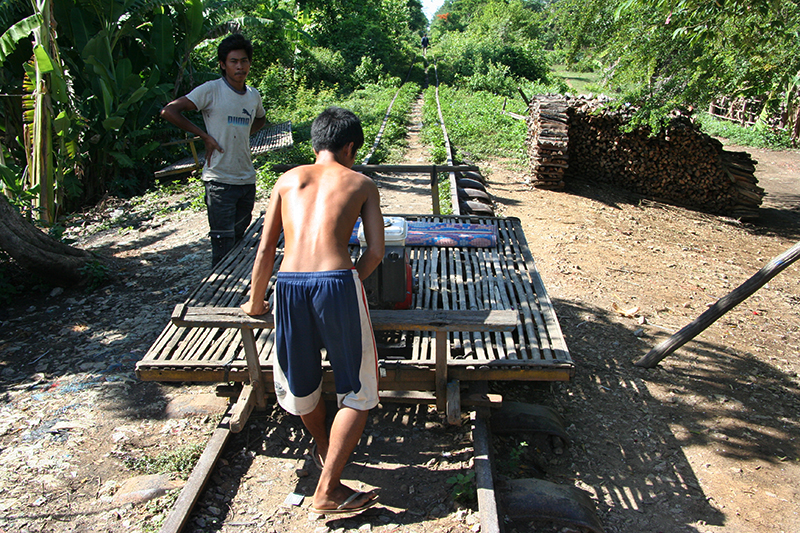 The most unusual means of transport here is the Bamboo Train that makes use of the old, narrow gauge railway line that links Battambang to the capital Phnom Penh. The regular train no longer operates as it took 10-12 hours to complete the 400km journey thanks to rail tracks that were misaligned as a result of exploding land mines. Ingenious locals have taken over. They build a train in a few minutes using two bogies over which they lay an ultralight bamboo frame. They then attach a 6HP gasoline engine and, with a push start, take off along the warped, French era, single track rail line. When two click-clacking bamboo trains meet head on, the less loaded one is quickly disassembled next to the rail line to allow the other to pass. Fortunately for us, we and our guide plus two bikes trumped everything coming the other way, even when we met a train with 6 people (though a considerable ‘discussion’ ensued between the drivers).
The most unusual means of transport here is the Bamboo Train that makes use of the old, narrow gauge railway line that links Battambang to the capital Phnom Penh. The regular train no longer operates as it took 10-12 hours to complete the 400km journey thanks to rail tracks that were misaligned as a result of exploding land mines. Ingenious locals have taken over. They build a train in a few minutes using two bogies over which they lay an ultralight bamboo frame. They then attach a 6HP gasoline engine and, with a push start, take off along the warped, French era, single track rail line. When two click-clacking bamboo trains meet head on, the less loaded one is quickly disassembled next to the rail line to allow the other to pass. Fortunately for us, we and our guide plus two bikes trumped everything coming the other way, even when we met a train with 6 people (though a considerable ‘discussion’ ensued between the drivers).
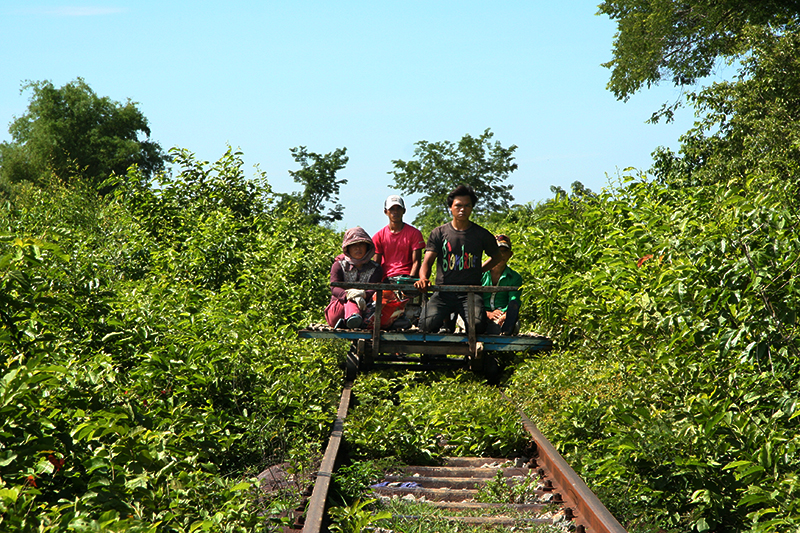 Between stops for oncoming traffic, the rail journey runs along a route that is overgrown with creeping green jungle. Occasionally, it reaches out to grab my arm or bash my head which can be quite painful when the little engine is pushing us along flat out. At times, the rails are so misaligned that I am sure we will be thrown into the jungle but, fortunately, the contraption steadies itself with a violent jolt. From time to time, we can glimpse the farmland through the wall of greenery that flanks the line. It remains flat and featureless other than the lone palm trees that are dotted about.
Between stops for oncoming traffic, the rail journey runs along a route that is overgrown with creeping green jungle. Occasionally, it reaches out to grab my arm or bash my head which can be quite painful when the little engine is pushing us along flat out. At times, the rails are so misaligned that I am sure we will be thrown into the jungle but, fortunately, the contraption steadies itself with a violent jolt. From time to time, we can glimpse the farmland through the wall of greenery that flanks the line. It remains flat and featureless other than the lone palm trees that are dotted about.
After a rickety 30 minutes, we arrive at the end of the line at a little hamlet called ‘O Sra Lav’ where we are met by the sound of oil drums being played Caribbean style on the left side of the rail line. This is part of a funeral celebration for an elderly woman who died yesterday and the noise is supposed to drive away her spirit in case she had done bad deeds during her lifetime. On the right side of the rail line are the dying embers of her funeral pyre set between green bamboo. A few close relatives squatted around the fire in silence as an old man stirred the red ashes. When it has all finished, the ashes will be placed in a corner of the family home, incense sticks will be burnt every day in front of the urn and each month time will be taken to remember and revere her memory.
Not wishing to appear as if we were prying into a family’s grief, we unloaded our bikes from the train and set off along the dirt roads of the countryside. Homes line the main arterial routes (roads and rivers) one dwelling deep almost continuously. Although there are a number of named villages, it is hard to determine where one begins and another ends. I doubt it matters; it’s not as if they need to have an address. All the shelters are made from wood, standing on stilts to provide a cooler area to rest during the day when the interior can get very hot. Lifting the living area off the ground is also a great benefit during the rainy season when everything is drenched in a wall of water.
We criss-cross the river several times using bridges made from a mixture of wood, twine and wire, They sway about alarmingly, making it difficult to drive the bikes down the centre line. Instead we wander from side to side, getting perilously close to the edge, and we must appear to the casual observer to have had one too many rice wines.
After the tension of river crossings and an assault course of dodging pot holes, we arrive at Wat Ek Phnom, an eleventh century temple that predates Angkor Wat by 100 years. This is too far away from anywhere of importance to attract foreign aid for restoration so it has become a collapsed ruin. It clearly represents the state in which every other religious relic would resemble had not overseas governments funded restoration of the most important temples.
Exactly the same story is told at another temple, Phnom Banan though this one has aged rather better. It’s exactly 358 uneven stone steps (so I am told) up to the top. Being hardened trekkers this is nothing to us and we took them in one go, an exercise I regretted at the top where I was dripping with sweat, much to the amusement of locals. On the summit stood a collection of small temples that remain standing but look as if a gust of wind would bring them crashing down. It’s a popular spot for locals who believe that a trip up the steps to pray in front of the Buddha will bring fertility. Just in case, I take the precaution of keeping Debbie well away from the Buddha’s gaze.
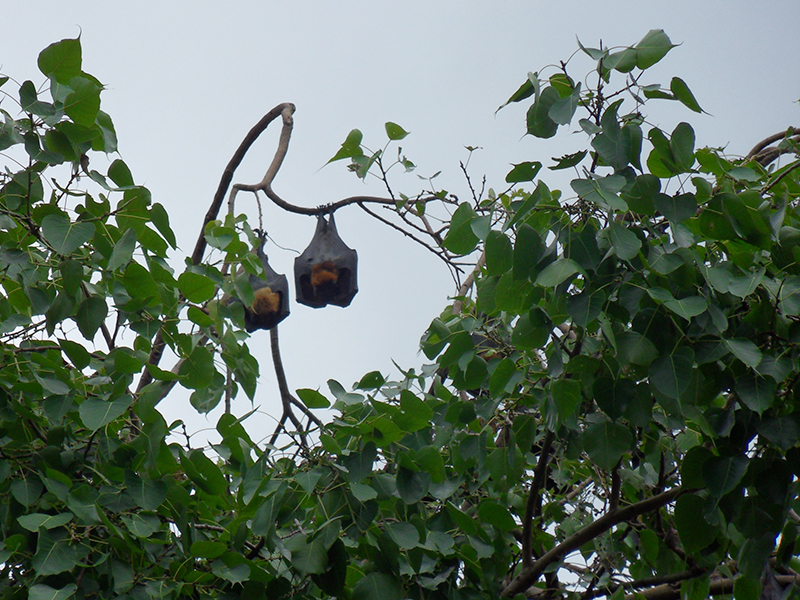 Near the base of the hill stood two large trees that were dripping with large fruit bats. Seth, our guide claimed that the two trees were home to 500 bats, a claim that seemed both possible and improbable at the same time. Seth shook the lower branches which drew many of the flying creatures into the air, squawking with complaint as they sought the refuge of higher boughs much to the annoyance of those who had sensibly already occupied safer areas. The hungry locals eye the bats avariously as a sought after delicacy. While the animals remain in or around the trees they have the protection of being in a holy area but, once they cross some imaginary line, they become a target for dinner.
Near the base of the hill stood two large trees that were dripping with large fruit bats. Seth, our guide claimed that the two trees were home to 500 bats, a claim that seemed both possible and improbable at the same time. Seth shook the lower branches which drew many of the flying creatures into the air, squawking with complaint as they sought the refuge of higher boughs much to the annoyance of those who had sensibly already occupied safer areas. The hungry locals eye the bats avariously as a sought after delicacy. While the animals remain in or around the trees they have the protection of being in a holy area but, once they cross some imaginary line, they become a target for dinner.
There are even more bats, small ones this time, living in caves around the largest hill known as Phnom Sampeau. Seth told us that 15 million bats live in these caves, coming out at dusk to feed off mosquitoes. Good on them as far as I’m concerned even if this colony is infected with rabies. Apparently, it takes almost an hour for all of them to exit the cave and, I guessed, it was important to distance ourselves from any flying insects.
To reach the top of the hill we had to ascend a steep concrete road that our 250cc trail bike could only manage in 1st gear. I wondered whether Debbie was putting on weight but thought it probably best not to ask. It couldn’t be me; I had just had my hair cut. Perhaps it was the ageing bike whose looks didn’t inspire confidence and whose handling made me wonder if it had been taken over by inebriated evil spirits. It certainly drank more than both of us put together.
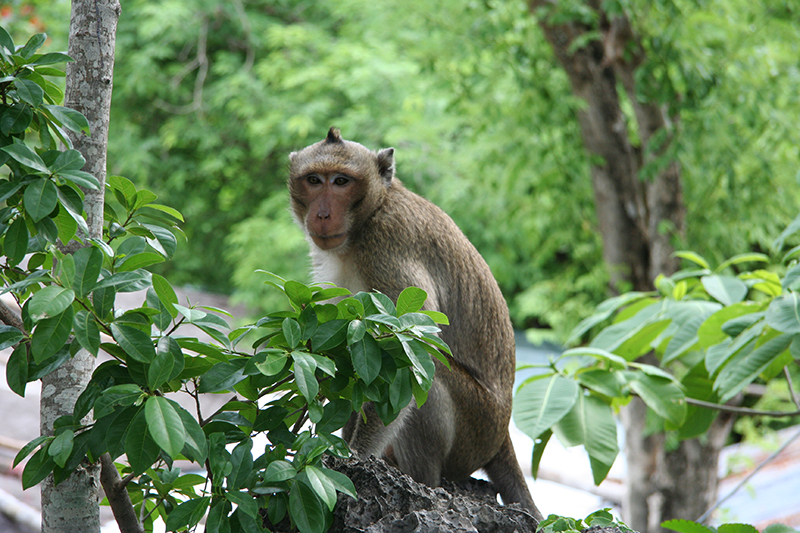 Gaining the summit of the hill, we were rewarded with long views across the flat land that reminded me of the great plains of Africa (only without the animals). I never imagined that Asia could be this flat and with its rich alluvian soil anyone could be forgiven for thinking this was prime farmland but locals cannot see beyond rice fields. Macaque monkeys stalk the summit, stealing banana and other fruit left as offerings to the Buddha icons by visitors and pilgrims. Skeletal dogs keep a close eye on them in the hope that they might drop their guard long enough to become a welcome feast.
Gaining the summit of the hill, we were rewarded with long views across the flat land that reminded me of the great plains of Africa (only without the animals). I never imagined that Asia could be this flat and with its rich alluvian soil anyone could be forgiven for thinking this was prime farmland but locals cannot see beyond rice fields. Macaque monkeys stalk the summit, stealing banana and other fruit left as offerings to the Buddha icons by visitors and pilgrims. Skeletal dogs keep a close eye on them in the hope that they might drop their guard long enough to become a welcome feast.
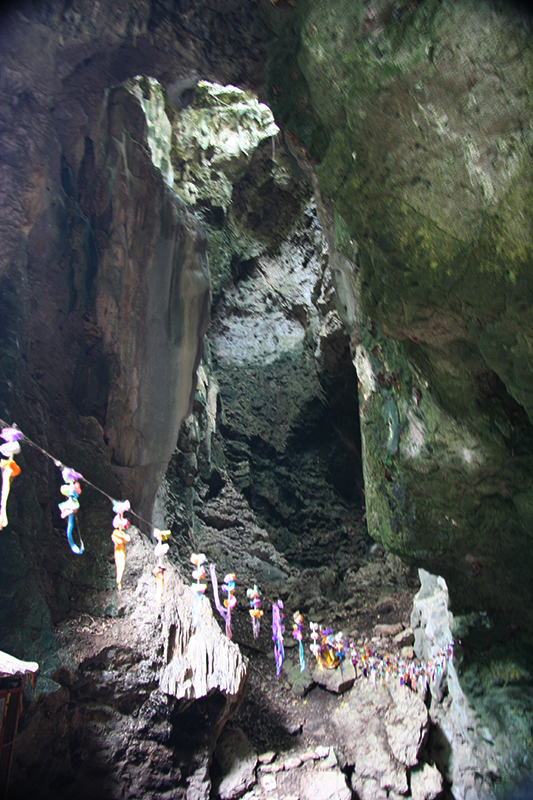 Apart from the magnificent views, this hill was also one of the last strongholds of the Khmer Rouge who were removed from the area only in 1998. Apparently, they managed to kill 10,000 people in the area, many of the victims being thrown 40 metres down a rocky chimney of a cave. A staircase, flanked by greenery, leads into a cavern where a golden, reclining Buddha lies peacefully next to a glass walled memorial filled with the broken skulls, bones and pieces of clothing of those bludgeoned by Khmer Rouge cadres before being thrown through the overhead skylight. The still air still smelled of death and, we sensed, that the chilly dark depths of the cave still held many corpses.
Apart from the magnificent views, this hill was also one of the last strongholds of the Khmer Rouge who were removed from the area only in 1998. Apparently, they managed to kill 10,000 people in the area, many of the victims being thrown 40 metres down a rocky chimney of a cave. A staircase, flanked by greenery, leads into a cavern where a golden, reclining Buddha lies peacefully next to a glass walled memorial filled with the broken skulls, bones and pieces of clothing of those bludgeoned by Khmer Rouge cadres before being thrown through the overhead skylight. The still air still smelled of death and, we sensed, that the chilly dark depths of the cave still held many corpses.
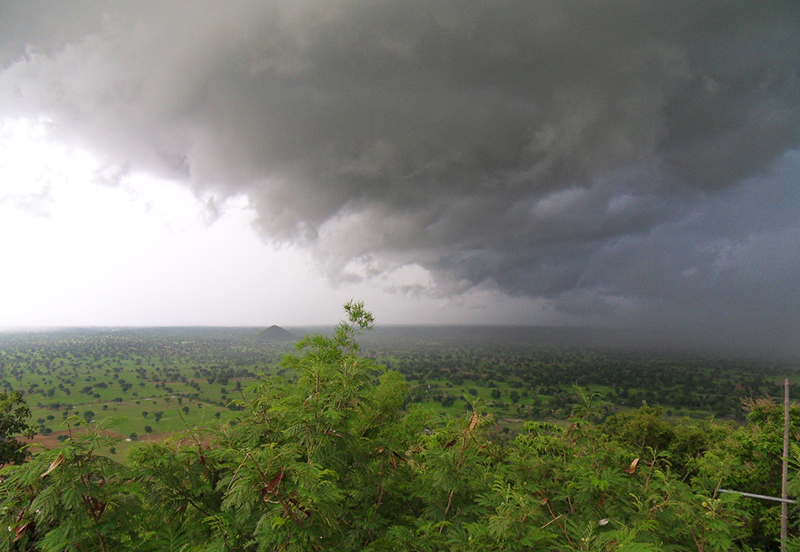 Coming out of the cave, the sky had darkened and we could clearly see a black thunder cloud, full of menace, rushing towards us. A drop in temperature combined with the sudden burst of wild wind announced the imminent downpour. We dashed to our bike in an attempt to get off the hill before the rain turned the road into a river. We were unable to avoid getting soaked but, at least, we made it before the route became treacherous and we sheltered for an hour or so under the cover of a roadside bar whilst the worst of the storm passed. As dusk fell and the rain dwindled to a light fall, we stood outside the bat caves waiting for them to emerge. I don’t know if it was the rain, the constant sound of thunder, or the evil spirit within our bike that frightened them but they remained indoors despite my shouts of encouragement to come out. The noise, amplified by the stone cave walls, was loud enough and strong enough for us to believe that there really was 15 million of them in the cave. So we gave up and rode back to town in the dark with the rain stinging our faces and forcing its way into every part of our bodies. But it was nothing that a couple of cold beers couldn’t rectify!
Coming out of the cave, the sky had darkened and we could clearly see a black thunder cloud, full of menace, rushing towards us. A drop in temperature combined with the sudden burst of wild wind announced the imminent downpour. We dashed to our bike in an attempt to get off the hill before the rain turned the road into a river. We were unable to avoid getting soaked but, at least, we made it before the route became treacherous and we sheltered for an hour or so under the cover of a roadside bar whilst the worst of the storm passed. As dusk fell and the rain dwindled to a light fall, we stood outside the bat caves waiting for them to emerge. I don’t know if it was the rain, the constant sound of thunder, or the evil spirit within our bike that frightened them but they remained indoors despite my shouts of encouragement to come out. The noise, amplified by the stone cave walls, was loud enough and strong enough for us to believe that there really was 15 million of them in the cave. So we gave up and rode back to town in the dark with the rain stinging our faces and forcing its way into every part of our bodies. But it was nothing that a couple of cold beers couldn’t rectify!
So, why did we want to come to Battambang? It’s still a good question and it’s still a question that we cannot answer convincingly.

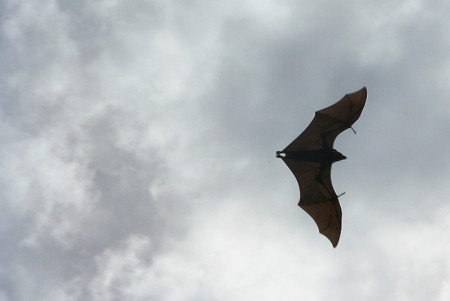
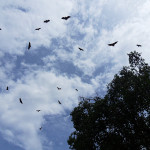
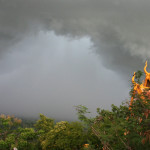
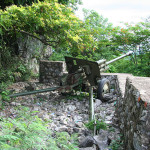
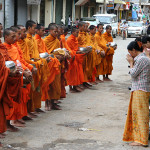
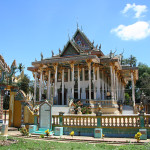
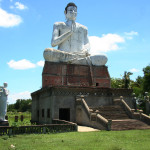
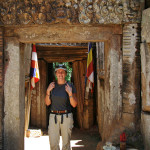
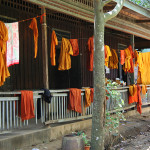
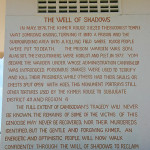
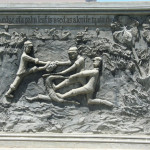
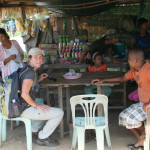
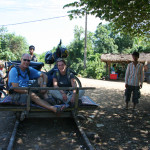
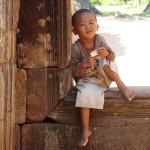
No comments yet.